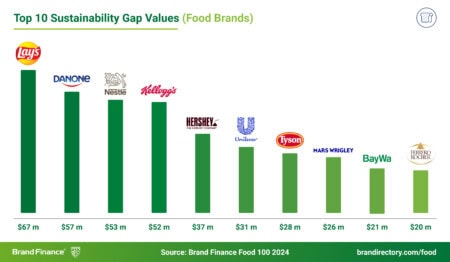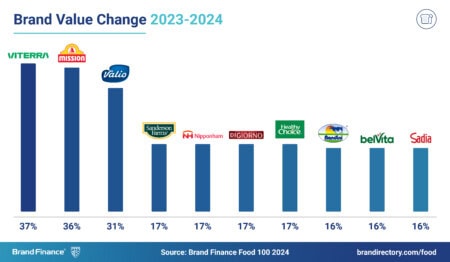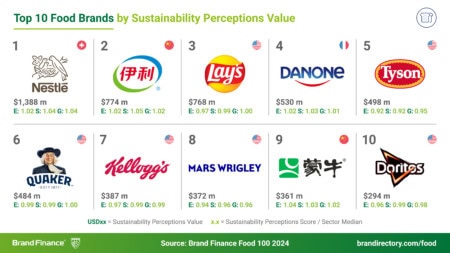Nestlé remains the world’s most valuable food brand at $20.8 billion while Lay’s rises to second place, valued at $12 billion
- Convenience foods see rising brand value due to demand
- Amul leads as the strongest food brand with an AAA+ rating
- Viterra is the fastest-growing food brand, with brand value up 37%
- Nestlé has the highest Sustainability Perceptions Value at $1.4 billion
- Lay’s has the highest positive gap value of $67 million
Nestlé (brand value down 7% to USD20.8 billion) continues to hold the title of the world’s most valuable food brand, according to a new report by Brand Finance, the world’s leading brand valuation consultancy. Despite a decline in brand value, Nestlé’s strong brand equity and resilience have helped it maintain its top position in the global food industry. Nestlé’s ability to adapt to changing consumer preferences and maintain a diverse product portfolio has been instrumental in its continued success.
Lay’s (brand value up 9% to USD12 billion) has climbed to the second position globally, surpassing Yili (brand value down 6% to USD11.6 billion) which holds the third spot. Lay’s strong financial performance and innovative product offerings, such as its Flavour Swap and MAX lineups, have contributed to its brand value growth.
The food and beverage sector has seen a 4% decline in brand value this year, totalling around USD268 billion. Consumers are increasingly favouring smaller, private label brands over big names for unique, personalised products.

Savio D’Souza, Valuation Director at Brand Finance, commented:
“The food and beverage industry is undergoing a rapid transformation driven by evolving consumer preferences. While the decline in brand value is a challenge, it also presents opportunities for innovation. Brands that successfully adapt to these trends by demonstrating strong brand purpose and delivering exceptional consumer experiences will be the ones to thrive in this new landscape.”
Convenience foods and dairy remain as major contributors, with convenience foods thriving due to busy lifestyles of consumers and dairy staying strong thanks to plant-based options and health trends. These shifts challenge established brands to adapt, while new brands capitalise on changing consumer preferences.
Leading brands in this segment include Healthy Choice (brand value up 17% to USD1.4 billion) and DiGiorno (brand value up 17% to USD1 billion), both of which have successfully adapted to changing consumer preferences through innovative product releases and strategic marketing.
Amul (brand value up 11% to USD3.3 billion) has risen to become the world’s strongest food brand, with a Brand Strength Index (BSI) score of 91.0 out of 100 and an AAA+ rating. Amul’s brand strength is attributed to its strong performance in familiarity, consideration, and recommendation metrics.

Meanwhile, new entrant Viterra (brand value up 37% to USD1.1 billion) has recorded the largest brand value growth by percentage in the ranking. This growth is supported by increased volumes, strategic acquisitions, and a higher BSI score, now at 60.6 out of 100.
Brand Finance also utilises its Global Brand Equity Monitor (GBEM) research to compile a Sustainability Perceptions Index. The study determines the role of sustainability in driving brand consideration across sectors and offers insight into which brands global consumers believe to be most committed to sustainability.
For individual brands, the Index displays the proportion of brand value attributable to sustainability perceptions. This Sustainability Perceptions Value is the financial value contingent on a brand’s reputation for acting sustainably. From here, Brand Finance’s perceptual research is analysed alongside CSRHub’s environmental, social and governance performance data to determine a brand’s ‘gap value’. This is the value at risk or to be gained, based on the difference between sustainability perceptions and actual performance.
The 2024 Sustainability Perceptions Index finds that in the food sector Nestlé has the highest Sustainability Perceptions Value at USD1.4 billion and Lay’s has the highest positive gap value of USD67 million among brands in the rankings. A positive gap value means that brand sustainability performance is stronger than perceived: brands can add value through enhanced communication about their sustainability efforts, so that perceptions are raised to fully account for the brand’s actual sustainability performance. Lay’s gap value suggests that it could generate an additional USD67 million in potential value through enhanced communication of its impact and accomplishments in sustainability.

